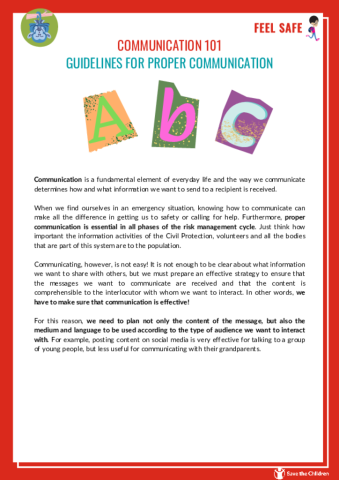Communication 101
Objectives:
- Experiment with different ways of communicating
- Develop problem solving
STEP BY STEP
Before starting
The teacher introduces the concept of communication applied to risk The possibility that a phenomenon may cause harm to people, settlements and the environment in a given period of time and in a given area management using the definition in the glossary:
Risk communication - interactive exchange of information and opinions between the scientific community, experts, policy makers and citizens regarding hazard elements, risk-related factors, risk perception, risk assessment findings and risk management decisions.
Emergency messages
The teacher divides the class into four groups. Each group has a set of blank cards (at least 20), a marker and a table on which to place the words to be used to compose the message.
The activity begins when the teacher gives the class the following delivery:
- Write a message to communicate an emergency that is occurring within the school.
- Use a maximum of 20 words (conjunctions and punctuation should also be considered as a single word).
- Once you have written the message (in a large enough format) cut out all the words and leave them separate on the desk.
- The message should be written as if it were a social media A freely accessible online platform that allows people to create, share and exchange ideas and text, image, audio and video content quickly on message boards read by people who follow the updates post - clear and direct communication!
You are given 15 minutes to write the message and sort the words on the counter.
Steal the word
The game consists of boycotting the other teams' message by stealing words and at the same time being ready to rewrite your own message when words are stolen by your opponents.
Rules of the game:
Each team will have a team leader. When the teacher claps twice, the group leader has to reach out to the first team in a clockwise direction and steal a word from the opposing team's message and bring it back to their own group. At this point the team that has had the word stolen must replace the stolen word with another one of equal or similar meaning (they may choose to replace it with 2 words but always within the limit of 20). You have 30 seconds to make the change.
The round is repeated when the teacher claps again. After clapping 5/6 times and finishing the substitutions of the stolen words, each group must read out the final message.
The team that has ensured the clearest and most complete information while staying within the 20-word limit wins.
Concluding thoughts
At the end of the activity, the teacher invites the students to reflect with the following questions:
- What does it mean to communicate?
- How many ways do you know of to communicate the same message?
- What can 'disrupt' communication?
- Why is clarity of communication important in an emergency?
To guide the discussion, the teacher can refer to the Guidelines for correct communication (see attached "Communication 101 - Guidelines for correct communication" below).

Add new comment